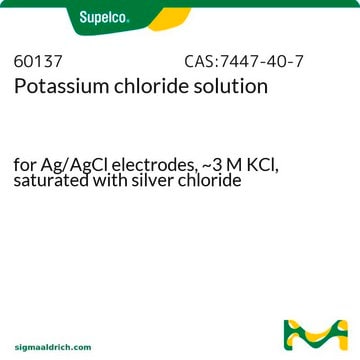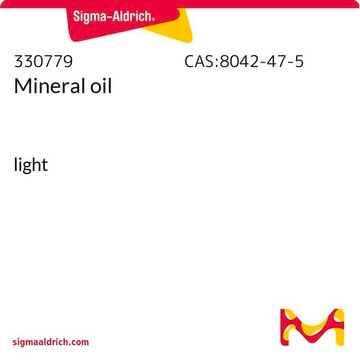All Photos(1)
About This Item
Linear Formula:
LiCl
CAS Number:
Molecular Weight:
42.39
MDL number:
UNSPSC Code:
26111700
PubChem Substance ID:
NACRES:
NB.61
Recommended Products
Quality Level
concentration
1 M in ethanol
density
0.83 g/mL at 20 °C
SMILES string
[Li+].[Cl-]
InChI
1S/ClH.Li/h1H;/q;+1/p-1
InChI key
KWGKDLIKAYFUFQ-UHFFFAOYSA-M
Looking for similar products? Visit Product Comparison Guide
Related Categories
General description
Lithium chloride solution is generally used as a liquid desiccant for hybrid solar desiccant cooling systems. Though it is corrosive in nature, it does not vaporize in air at ambient conditions.
Application
Filling solution for reference electrodes used for titrations in nonaqueous solutions
Signal Word
Danger
Hazard Statements
Precautionary Statements
Hazard Classifications
Eye Irrit. 2 - Flam. Liq. 2
Storage Class Code
3 - Flammable liquids
WGK
WGK 1
Flash Point(F)
57.2 °F - closed cup
Flash Point(C)
14 °C - closed cup
Personal Protective Equipment
dust mask type N95 (US), Eyeshields, Gloves
Choose from one of the most recent versions:
Already Own This Product?
Find documentation for the products that you have recently purchased in the Document Library.
Customers Also Viewed
Study of an aqueous lithium chloride desiccant system: air dehumidification and desiccant regeneration
Fumo, Nelson, and D. Y. Goswami.
Solar Energy, 72 (4), 351-361 (2002)
A Abu-Baker et al.
Cell death & disease, 4, e821-e821 (2013-10-05)
Expansion of polyalanine tracts causes at least nine inherited human diseases. Among these, a polyalanine tract expansion in the poly (A)-binding protein nuclear 1 (expPABPN1) causes oculopharyngeal muscular dystrophy (OPMD). So far, there is no treatment for OPMD patients. Developing
J Li et al.
Cell death & disease, 4, e832-e832 (2013-10-05)
Dexamethasone (Dex)-induced osteoporosis has been described as the most severe side effect in long-term glucocorticoid therapy. The decreased bone mass and the increased marrow fat suggest that Dex possibly shifts the differentiation of bone marrow stromal cells (BMSCs) to favor
Aitor González et al.
PloS one, 8(1), e53323-e53323 (2013-01-18)
The mouse segmentation is established from somites, which are iteratively induced every two hours from the presomitic mesoderm (PSM) by a system known as the segmentation clock. A crucial component of the segmentation clock is the gene Hes7, which is
A Briolay et al.
Biochemical and biophysical research communications, 430(3), 1072-1077 (2012-12-26)
Although anti-tumor necrosis factor (TNF)-α treatments efficiently block inflammation in ankylosing spondylitis (AS), they are inefficient to prevent excessive bone formation. In AS, ossification seems more prone to develop in sites where inflammation has resolved following anti-TNF therapy, suggesting that
Our team of scientists has experience in all areas of research including Life Science, Material Science, Chemical Synthesis, Chromatography, Analytical and many others.
Contact Technical Service









